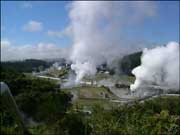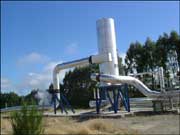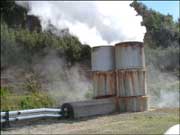6. Bore Field Equipment
Bores and Borefields
Bores, (also called Wells) are the holes drilled into the
ground to extract hot water and steam.
In the Wairakei Borefield the bores reach a depth of up to 2200m. However
the deepest bores do not always produce more because they intersect a fault plane or are drilled into very
porous or fractured rock where steam and water can flow more easily.
Throughout the Borefield the bores are not evenly spaced but are grouped above the most productive areas of steam and water.
The Wairakei Borefield has three main areas of production:
- Eastern Borefield
This was the main production area in the 1960's. However its pressure dropped and the reservoir temperature also fell, due to the inflow of cool water. - Western Borefield
About 50% of Wairakei Power Station's steam presently comes from the Western Borefield. It consists of about 30 wells drilled to a depth of about 600m. - Te Mihi Borefield
The remaining 50% of Wairakei Power Station steam presently comes from the Te Mihi Borefield, which produces dry steam from a shallow (330-500m) high pressure (18-25 Bar) steam zone. Below this depth, is a large reservoir of hot water at a temperature of more than 250°C.
Well heads
Well heads are the concrete cellars and equipment used to
- support valves and separators that control the flow of water and steam from the well
- supports the drill rig while drilling or working down the well
The design of well heads has also changed over time:
- Older wells have steam separators built into them, with one separator on each. Modern wells share separators.
- Older Well Heads were excavated below ground level to help to support the structure. This resulted in a 'cellar' being formed. Modern well heads are level with the ground which helps to prevent the trapping of poisonous gases such as hydrogen sulfide and carbon dioxide.
Steam Separators
Separators separate dry steam and hot water.
Wairakei geothermal field contains mainly pressurised water at a temperature of 230-250 oC. However when this water reaches the surface the pressure on the water drops and the water boils as it rises within the well to become a mixture of about 80% water and 20% steam.
Only the steam can be used to drive the turbines so the
water must be separated.
The separation technique used was invented by the original Wairakei engineers
in the 1950's and uses the fact that water droplets are heavier than steam.
It relies on:
- The steam and water mixture entering the separator at high speed and at an angle.
- The water droplets having a greater mass than the steam, so they fly to the outside
- The lighter steam molecules collect in the centre. They are then piped up and out to the Power Station.
The water from the separators may then be discharged or pass to a Flash Plant depending on its temperature and pressure.
Flash Plants
Flash plants produce extra steam from hot water discharged from separators. Flash plants produce steam by reducing the pressure rather than raising the temperature of the water.
The Flashed steam can then be piped to the Power Station, in separate pipes as it as at a lower pressure, and used for extra generation.
Silencers
A silencer reduces the noise of steam escaping into the atmosphere.
Silencers are needed because of the noise created by the pressurised hot water escaping to the atmosphere and producing flashed steam. Without a silencer even a small steam discharge could cause deafness, headaches, and dizziness in people working nearby. With all 54 bores discharging, the noise from the Wairakei Borefield would be heard 10Km away.
Within the Silencers there is also separation of steam and water along with the production of massive clouds of water vapour. These clouds are the most obvious feature to visitors.
Pipelines
The Pipelines at Wairakei carry both hot water and steam and extend between Borefield, Power Station, Waikato River and Reinjection wells.
| Main Steam Lines |
10 |
| Diameter | 300 -1200mm |
| Intermediate Pressure Steam | 1200 Tonnes per hour |
| Intermediate -Low Pressure Steam | 250 Tonnes per hour |
| Cladding | Aluminium |
| Insulation |
CaSiO3 or fibreglass Asbestos in older pipes |
| Pipe | Mild steel |
| Expansion - Contraction requirement | 5 - 10m over length.1m per kilometre of pipe |
| Speed of steam in pipes |
About 100 kph or 30m/s |
| Travel time from bore to turbine | 2 -3 minutes |






